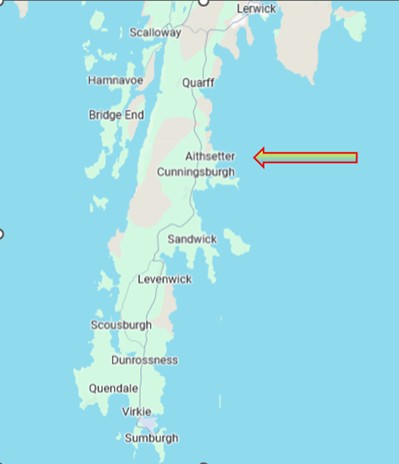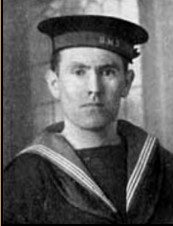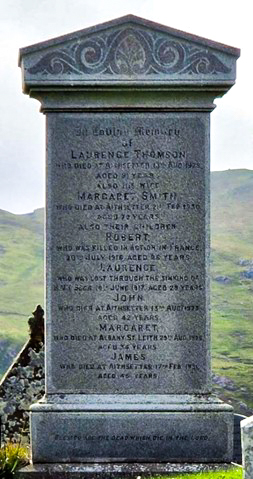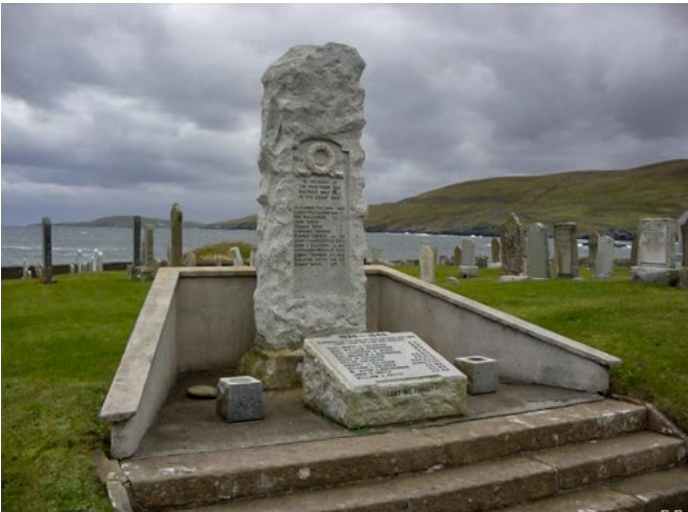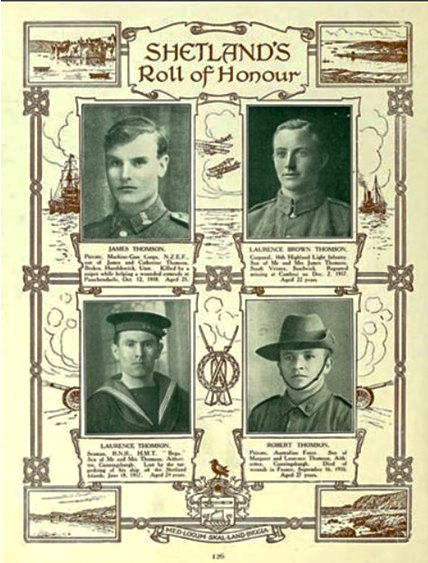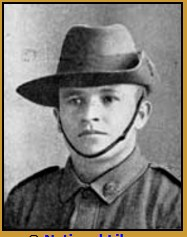
Robert THOMSON
Eyes brown, Hair brown, Complexion sallow
Robert THOMSON – A Shetland Shipwright at Fromelles
Can you help find Robert?
Robert Thompson’s body was never found after the Battle of Fromelles and there are no records of his burial.
A mass grave was found in 2008 at Fromelles, a grave the Germans dug for 250 Australian soldiers they recovered after the battle. As of 2024, 180 of these soldiers have been able to be identified via DNA testing.
Robert may be among these remaining 70 unidentified men. There is still a chance to identify him — but we need help. We welcome all branches of his family to come forward to donate DNA to help with his identification, especially from the Thomson and Smith heritage in Shetland Isles, Scotland or wherever they are scattered.
See the DNA box at the end of the story for what we do know about his family.
If you know anything of contacts for Walter, please contact the Fromelles Association.
Early Life
Robert Thomson was born on 11 September 1889 in Aithsetter, Cunningsburgh, Shetland, Scotland, the son of Laurence Thomson (1848–1929), a farmer, and Margaret Smith (1857–1930). He was the grandson of John Thomson (1805–1883), a respected local school teacher, and Joan Inkster (1806–1892) on his father’s side, and John Smith (1812–1887) and Margaret Jamieson (1822–1897) on his mother’s side.
He grew up in a large family of nine surviving children:
- John Thomson (1880–1923)
- Peter Jeremiah Thomson (1883–1948) m Laura Smith
- James Thomson (1885–1931)
- Laurence Thomson (1886–1917) Lost at Sea, H.M. Trawler B90 Bega
- Robert Thomson (1889-1916) Killed in Action at Fromelles
- Margaret Thomson (1891–1926)
- Joan Inkster Thomson (1893–1979) m Alfred Burgess
- Grace Agnes Thomson (1896–1933) m Magnus Smith
- William George Thomson (1901–1968) m Janet Irvine
The family did suffer the loss of several infants who died young. His brother Laurence would later serve in the Royal Naval Reserve and, like Robert, would not survive the war.
The Thomsons lived in Aithsetter, a crofting and fishing community overlooking the North Sea, where Laurence worked the land while also engaging in the seasonal fishing common to the district.
The 1891 Scotland Census records Robert, aged 1, living with his parents, five older siblings, and two elderly relatives — his grandmother Joan and his aunt Joan — in the family home at Aithsetter. By the 1901 Census, Robert was 11 years old and attending school in Cunningsburgh, helping with work on the croft alongside his studies.
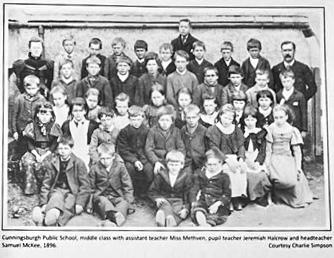
After completing school, Robert was apprenticed as a shipwright with William Denny & Brothers Limited in Dumbarton, one of Scotland’s most innovative shipyards. Denny’s was renowned for building fine cross-channel steamships and ferries, pioneering ship stabilisers, and operating the world’s first commercial ship testing tank. Robert spent five and a half years there, gaining a highly respected trade qualification. However, seeking better opportunities, Robert left Scotland in 1914 and travelled to Australia.
Shipping records show he departed London aboard the SS Ionic on 1 May 1914, arriving in Hobart, Tasmania, on 11 June 1914. He later moved to Melbourne, where he quickly found work in his trade and settled into Australian life. Friends later recalled that he spoke “in glowing terms” about Australia and the conditions of life there, but when war came, he felt the pull of duty to serve his new country.
Off to War
Robert enlisted in the Australian Imperial Force on 7 July 1915 at Melbourne, joining D Company of the newly formed 31st Battalion. The 31st Battalion was formed with two companies from Queensland and two companies from Victoria. Victorian enlistees trained at the camp at Flemington Depot and then at Broadmeadows. The full battalion were joined in early October at Broadmeadows. Before sailing from Melbourne on 9 November aboard the troopship Wandilla, the 991 soldiers of the 31st had been on parade in Melbourne in front of a good crowd.
The Minister for Defence, H.F. Pearce said:
“I do not think I have ever seen a finer body of men.”
The battalion embarked from Melbourne on HMAT A62 Wandilla on 9 November 1915, bound for Egypt. They disembarked at Suez on 7 December 1915 and travelled by train to their camp at Tel-el-Kebir. They were first sent to Serapeum to continue their training and to guard the Suez Canal from any potential threats posed by the Ottoman Army. Near the end of February they moved to the large camp at Tel-el-Kebir , which was about 110 km northeast of Cairo. The 40,000 men in the camp were comprised of Gallipoli veterans and the thousands of reinforcements arriving regularly from Australia. The 60 km trip must have been unpleasant, as it was reported that they were moved in “dirty horse trucks.”
Source: AWM4 23/48/7, 31st Battalion War Diaries, Feb 1916, page 5
The next move was at the end of March, back to the Suez Canal at the Ferry Post and Duntroon Camps and then finally to Moascar at the end of May. The months passed in training and sightseeing, but by the time the 31st Battalion was transferred to France, the men were all heartily sick of Egypt.
Private Les Smith’s (934) letter home pretty well sums it up:
“We are eating dust and sand pretty near all day. It is couple of few feet deep and not a tree to be seen for miles. We are drilling in this and the heat of the sun which is about 100 in the shade.”
On 15 June, the 31st Battalion began to make their way to the Western Front, first by train from Moascar to Alexandria and then sailing to Marseilles. A, B and D companies were aboard the troopship Hororata and C company aboard the Manitou. After disembarking on 23 June, they were immediately boarded onto trains to Steenbeque and then marched to their camp at Morbecque, 35 km from Fleurbaix in northern France, arriving on 26 June. The battalion strength was 1019 soldiers.
The area near Fleurbaix was known as the “Nursery Sector” – a supposedly relatively quiet area where inexperienced Allied troops could learn the harsh realities of Western Front trench warfare against the Germans. But the quiet times and the training period did not last long. Training continued, now with how to handle poisonous gas included in their regimen. They began their move towards Fromelles on 8 July and by 11 July they were into the trenches for the first time, in relief of the 15th Battalion.
The Battle of Fromelles
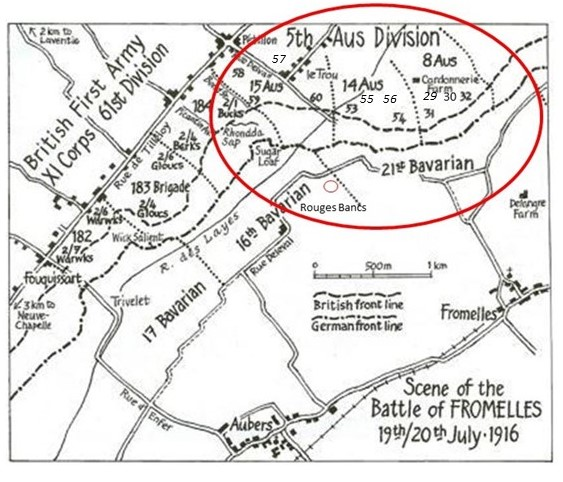
The overall plan was to use brigades from the Australian Fifth Division to conduct a diversionary assault on the German trenches at Fromelles. The main attack was planned for the 17th, but bad weather caused it to be postponed. On the 19th they were back into the trenches and in position at 4.00 PM. The Zero Hour for advancing from their front-line trenches was to be 5.45 PM, but the Germans knew this attack was coming and were well-prepared:
“Just prior to launching the attack, the enemy bombardment was hellish, and it seemed as if they knew accurately the time set.”
The assault began at 5.58 PM and they went forward in four waves, A and C Company in the first two waves and Robert’s D and B Companies in the 3rd and 4th waves. There were machine gun emplacements to their left and directly ahead at Delrangre Farm and there was heavy artillery fire in No-Man’s-Land. The pre battle bombardment did have a big impact and by 6.30 PM the Aussies were in control of the German’s 1st line system (Trench B in the diagram below), which was described as “practically a ditch with from 1 to 2 feet of mud and slush at the bottom.”
Source: AWM4 23/49/12, 32nd Battalion War Diaries, July 1916, page 11

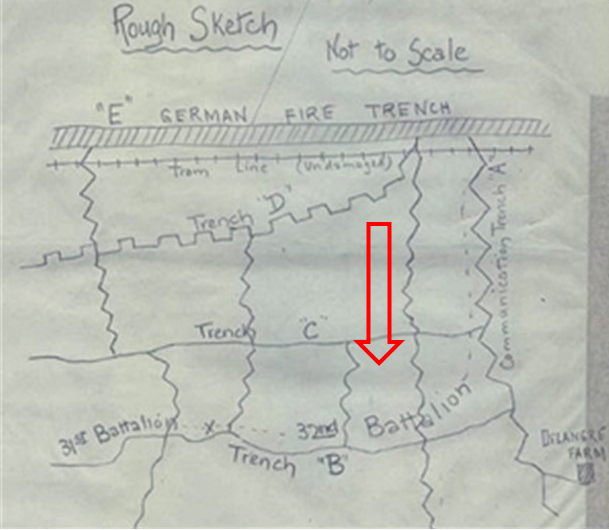
Unfortunately, with the success of their attack, ‘friendly’ artillery fire caused a large number of casualties. By 8.30 PM the Australians’ left flank had come under heavy bombardment with high explosives and shrapnel. Return bombardment support was provided and the 32nd, who also had the job of holding the flank to the left of the 31st, were told that “the trenches were to be held at all costs”.
Source: AWM4 23/49/12, 32nd Battalion War Diaries, July 1916, page 12
Robert was among those who reached the German trenches. Sergeant Robert Batteram (353) recalled:
“About 9.00 PM on [the] 19th, when he was slightly wounded in the arm, he tried to get me back. He helped me put my dressing on [my] leg, then crawled away, as [the] order to retire was given, leaving us poor devils who could not get back. He wanted to carry me, but the shell fire was pretty bad and the distance was great, so he left me.”
Another comrade told the Shetland Times:
“He was a good lad, always bright and liked by everybody, and a good soldier. The last time I saw him was in the German trench, when he was called to a machine gun.”
These were the last of the records of what happened to Robert. Fighting continued through the night. The Australians made a further charge at the main German line beyond Trench B, but they were low on grenades, there was machine-gun fire from behind from the emplacement at Delangre Farm and they were so far advanced that they were getting shelled by both sides. At 4.00 AM the Germans began an attack from the Australian’s left flank, bombing and advancing into Trench A (map).
Given the Australian advances that had been made earlier, portions of the rear Trench E had been left almost empty, which then enabled the Germans to be in a position to surround the soldiers. At 5.30 AM the Germans attacked from both flanks in force and with bombing parties. Having only a few grenades left themselves, the only resistance the 31st could offer was with rifles:
“The enemy swarmed in and the retirement across No Mans’ Land resembled a shambles, the enemy artillery and machine guns doing deadly damage.”
The 31st were out of the trenches by the end of the day on the 20th. From the 1019 soldiers who left Egypt, the initial impact was assessed as 77 soldiers were killed or died from wounds, 414 were wounded and 85 were missing, including Robert. To get some perspective of the battle, when Charles Bean, Australia’s official war historian, attended the battlefield two and half years later, he observed a large quantity of bones, torn uniforms and Australian kit still on the battlefield.
The ultimate total was that 162 soldiers of the 31st were either killed or died from wounds and of this total 82 were missing/unidentified. The bravery of the soldiers of the 31st was well recognised by their own Battalion commanders.
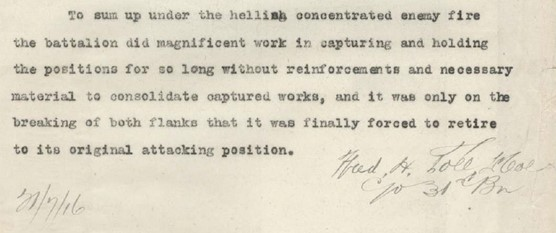
After the Battle - Robert did not return
Robert did not return when the 31st Battalion withdrew from the German trenches in the early hours of 20 July 1916. His name first appeared on the list of wounded and missing, which was sent to his family in Aithsetter, Shetland, in October 1916. News eventually reached his father, Laurence at Aithsetter, via the Headquarters of the AIF in London.
The Shetland Times published the sombre update:
“Mr Laurence Thomson, Aithsetter, Cunningsburgh, has learned on enquiry at Headquarters of the Australian Imperial Force, London, that his son, Private Robert Thomson, 31st Battalion, 8th Infantry Brigade, A.I.F., was reported wounded and missing in France since the 20th July. Much sympathy is felt for his parents and family in their anxious waiting for further information.”
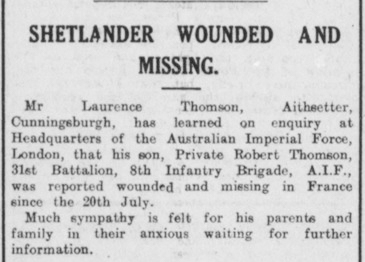
For the next year his family endured uncertainty, until a Court of Enquiry convened in the field on 1 August 1917 officially determined that Robert had been killed in action on 20 July 1916. However, his service record does carry a handwritten, undated note of a general location, but does offer some hope to ulitmately find him:
“Buried in the vicinity of Fleurbaix, Sh. 36 NW.”
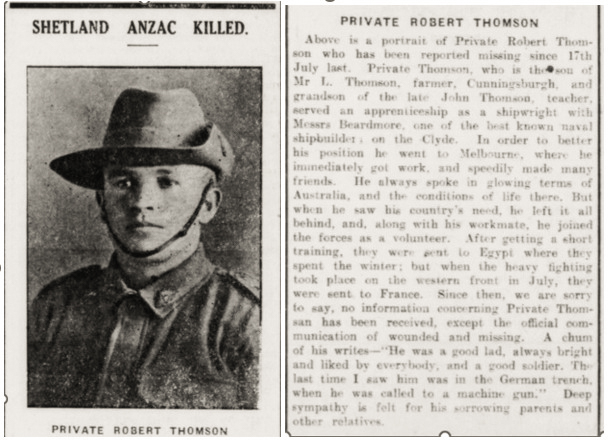
He was awarded the 1914-15 Star Medal, the British War Medal, the Victory Medal, a Memorial Plaque and a Memorial Scroll.
With no known resting place, Robert is commemorated at the V.C. Corner Australian Cemetery and Memorial, Fromelles, where his name appears on Panel No. 4, and also on the Australian War Memorial Roll of Honour (Panel 119) in Canberra.
The Family Mourns – but does not forget
The loss was deeply felt at home. Less than a year after Robert’s death, the Thomsons suffered a second loss. His older brother Laurence, serving with the Royal Naval Reserve aboard H.M. Trawler B90 Bega, was drowned when the vessel was sunk in the North Sea on 18 June 1917. Local reports noted that he was “a most promising young man” and “just about to get married,” and recorded that he was the second son Mr and Mrs Thomson had lost in the war.
Source: “Cunningsburgh Man Drowned.” The Shetland Times, 23 June 1917, p.4. Courtesy of the British Library Board. FindmyPast
Among the treasured family mementoes was a finely worked swivel brooch, containing photographs of Robert in his Australian uniform and his brother Laurence, who was also lost in the war.
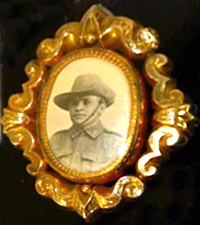
Losing two sons was devestating for the family, but they have not been forgotten. They both are remembered on the family headstone at Aithsetter Cemetery, which records his death alongside those of his parents and siblings.
They are also remembered at the Cunningsburgh War Memorial, standing in the village as a permanent tribute to those from the parish who never returned and the Shetland’s Roll of Honour.
More than a century later, Robert Thomson’s story continues to be remembered in both Shetland and Australia. On 10 November 2018, as part of Armistice centenary commemorations, his image was projected onto the walls of Lerwick Town Hall alongside that of his brother Laurence. This striking visual tribute, with their faces illuminated between red poppies, symbolised the enduring bond between the two brothers and the high cost paid by one Shetland family in the Great War.
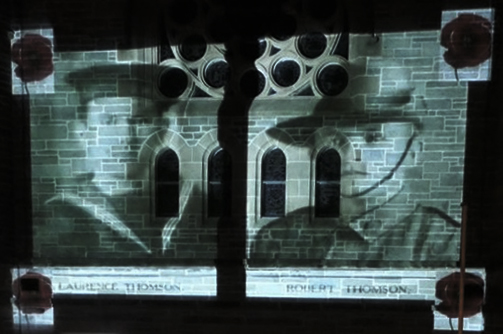
Through memorials, newspaper records, family heirlooms, and public commemorations, Robert’s name endures — not only as a soldier of the 31st Battalion, but as a son, brother, and Shetlander who made the ultimate sacrifice far from home.
Finding Robert
Robert’s remains were not recovered, he has no known grave. After the battle, the Germans recovered 250 Australian soldiers and placed them in a burial pit at Pheasant Wood. This grave was discovered in 2008 and since then efforts have been underway to identify these soldiers by DNA testing from family members. As of 2024, 180 of the soldiers have been identified, including 23 of the 82 unidentified soldiers from the 31st Battalion.
We welcome all branches of Robert’s family to come forward to donate DNA to help with his identification - especially from the Thomson and Smith heritage in Shetland or wherever they are scattered. If you know anything of family contacts, please contact the Fromelles Association.
We hope that one day Robert will be named and honoured with a known grave.
Please visit Fromelles.info to follow the ongoing identification project and Robert’s story.
DNA samples are being sought for family connections to this family from the Shetland Isles, Scotland - Aithsetter Cunningsburgh
| Soldier | Robert Thomson (1889–1916) |
| Parents | Lawrence Thomson (1848–1929) & Margaret Smith (1857–1930) |
| Siblings | John Thomson (1880–1923) | ||
| Peter Jeremiah Thomson (1883–1948) m Laura Smith | |||
| James Thomson (1885–1931) | |||
| Laurence Thomson (1886–1917) | |||
| Margaret Thomson (1891–1926) | |||
| Joan Inkster Thomson (1893–1979) m Alfred Burgess | |||
| Grace Agnes Thomson (1896–1933) m Magnus Smith | |||
| William George Thomson (1901–1968) m Janet Irvine |
| Grandparents | |||
| Paternal | John Thomson (1805–1883) & Joan Inkster (1806–1892) | ||
| Maternal | John Smith (1812–1887) & Margaret Jamieson (1822–1897) |
Links to Official Records
Seeking DNA Donors

Contacts
(Contact: carla@fromelles.info or geoffrey@fromelles.info).
(Contact: army.uwc@defence.gov.au or phone 1800 019 090).
Donations
If you are able, please contribute to the upkeep of this resource.
(Contact: bill@fromelles.info ).
